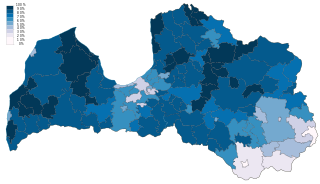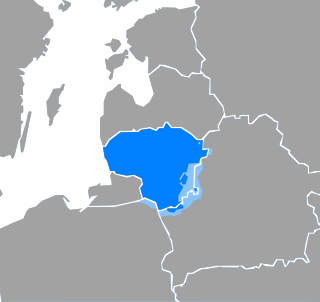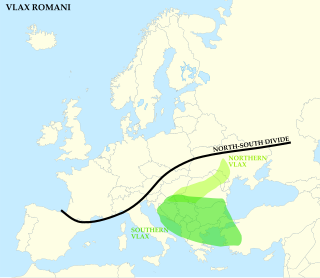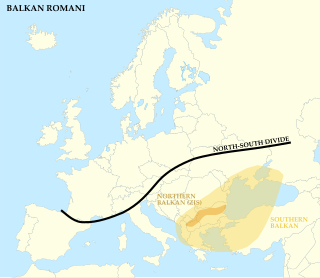Related Research Articles

The Baltic languages are a branch of the Indo-European language family spoken natively or as a second language by a population of about 6.5–7.0 million people mainly in areas extending east and southeast of the Baltic Sea in Europe. Together with the Slavic languages, they form the Balto-Slavic branch of the Indo-European family.

The Latvian language, also known as Lettish, is an Eastern Baltic language belonging to the Baltic branch of the Indo-European language family, spoken in the Baltic region. It is the language of Latvians and the official language of Latvia as well as one of the official languages of the European Union. There are about 1.2 million native Latvian speakers in Latvia and 100,000 abroad. Altogether, 2 million, or 80% of the population of Latvia, spoke Latvian in the 2000s, before the total number of inhabitants of Latvia slipped to less than 1.9 million in 2022. Of those, around 1.16 million or 62% of Latvia's population used it as their primary language at home, though excluding the Latgale region it is spoken as a native language in villages and towns by over 90% of the population.

Lithuanian is an Eastern Baltic language belonging to the Baltic branch of the Indo-European language family. It is the official language of Lithuania and one of the official languages of the European Union. There are approximately 2.8 million native Lithuanian speakers in Lithuania and about 1,000,000 speakers elsewhere. Around half a million inhabitants of Lithuania of non-Lithuanian background speak Lithuanian daily as a second language.

The Indo-Aryan languages are a branch of the Indo-Iranian languages in the Indo-European language family. As of the early 21st century, they have more than 800 million speakers, primarily concentrated in India, Pakistan, Sri Lanka, Bangladesh, Nepal and Maldives. Moreover, apart from the Indian subcontinent, large immigrant and expatriate Indo-Aryan–speaking communities live in Northwestern Europe, Western Asia, North America, the Caribbean, Southeast Africa, Polynesia and Australia, along with several million speakers of Romani languages primarily concentrated in Southeastern Europe. There are over 200 known Indo-Aryan languages.
Romani is an Indo-Aryan macrolanguage of the Romani communities. According to Ethnologue, seven varieties of Romani are divergent enough to be considered languages of their own. The largest of these are Vlax Romani, Balkan Romani (600,000), and Sinte Romani (300,000). Some Romani communities speak mixed languages based on the surrounding language with retained Romani-derived vocabulary – these are known by linguists as Para-Romani varieties, rather than dialects of the Romani language itself.

The Sinti are a subgroup of Romani people. They are found mostly in Germany, France and Italy and Central Europe, numbering some 200,000 people. They were traditionally itinerant, but today only a small percentage of Sinti remain unsettled. In earlier times, they frequently lived on the outskirts of communities.

The Balto-Slavic languages form a branch of the Indo-European family of languages, traditionally comprising the Baltic and Slavic languages. Baltic and Slavic languages share several linguistic traits not found in any other Indo-European branch, which points to a period of common development and origin.
A mixed language is a language that arises among a bilingual group combining aspects of two or more languages but not clearly deriving primarily from any single language. It differs from a creole or pidgin language in that, whereas creoles/pidgins arise where speakers of many languages acquire a common language, a mixed language typically arises in a population that is fluent in both of the source languages.
Angloromani or Anglo-Romani is a mixed language of Indo-European origin involving the presence of Romani vocabulary and syntax in the English used by descendants of Romanichal Travellers in the United Kingdom, Australia, Canada, New Zealand, United States, and South Africa.

Proto-Baltic is the unattested, reconstructed ancestral proto-language of all Baltic languages. It is not attested in writing, but has been partly reconstructed through the comparative method by gathering the collected data on attested Baltic and other Indo-European languages. It represents the common Baltic speech that approximately was spoken between the 3rd millennium BC and ca. 5th century BC, after which it began dividing into Western and Eastern Baltic languages. Proto-Baltic is thought to have been a fusional language and is associated with the Corded Ware and Trzciniec cultures.

Vlax Romani is a dialect group of the Romani language. Vlax Romani varieties are spoken mainly in Southeastern Europe by the Romani people. Vlax Romani can also be referred to as an independent language or as one dialect of the Romani language. Vlax Romani is the second most widely spoken dialect subgroup of the Romani language worldwide, after Balkan Romani.
The Romani language has for most of its history been an entirely oral language, with no written form in common use. Although the first example of written Romani dates from 1542, it is not until the twentieth century that vernacular writing by native Romani people arose.

Domari is an endangered Indo-Aryan language, spoken by Dom people scattered across the Middle East and North Africa. The language is reported to be spoken as far north as Azerbaijan and as far south as central Sudan, in Turkey, Iran, Iraq, Palestine, Israel, Jordan, Egypt, Sudan, Libya, Tunisia, Algeria, Morocco, Syria and Lebanon. Based on the systematicity of sound changes, it is known with a fair degree of certainty that the names Domari and Romani derive from the Indo-Aryan word ḍom. Although they are both Central Indo-Aryan languages, Domari and Romani do not derive from the same immediate ancestor. The Arabs referred to them as Nawar as they were a nomadic people that originally immigrated to the Middle East from the Indian subcontinent.

In linguistic morphology, inflection is a process of word formation in which a word is modified to express different grammatical categories such as tense, case, voice, aspect, person, number, gender, mood, animacy, and definiteness. The inflection of verbs is called conjugation, and one can refer to the inflection of nouns, adjectives, adverbs, pronouns, determiners, participles, prepositions and postpositions, numerals, articles, etc., as declension.

Balkan Roma, Balkaniko Romanes, or Balkan Gypsy is a specific non-Vlax dialect of the Romani language, spoken by groups within the Balkans, which include countries such as Albania, Bosnia-Herzegovina, Bulgaria, Greece, Kosovo, North Macedonia, Serbia, Slovenia, Turkey etc. The Balkan Romani language is typically an oral language.
Para-Romani are various mixed languages of non-Indo-Aryan linguistic classification containing considerable admixture from the Romani language. They are spoken as the traditional vernacular of Romani communities, either in place of, or alongside, varieties of the Romani language. Some Para-Romani languages have no structural features of Romani at all, taking only the vocabulary from Romani.
Sinte Romani is the variety of Romani spoken by the Sinti people in Germany, France, Austria, Belgium, the Netherlands, some parts of Northern Italy and other adjacent regions. Sinte Romani is characterized by significant German influence and is not mutually intelligible with other forms of Romani. The language is written in the Latin script.

Northern Romani is group of dialects of the Romani language spoken in various Northern European, Central European and Eastern European countries.

Carpathian Romani, also known as Central Romani or Romungro Romani, is a group of dialects of the Romani language spoken from southern Poland to Hungary, and from eastern Austria to Ukraine.
Early Romani is the latest common predecessor of all forms of the Romani language. It was spoken before the Roma people dispersed throughout Europe. It is not directly attested, but rather reconstructed on the basis of shared features of existing Romani varieties. Early Romani is thought to have been spoken in the Byzantine Empire between the 9th-10th and 13th-14th centuries.
References
- ↑ Baltic Romani at Ethnologue (25th ed., 2022)

Finnish Kalo at Ethnologue (25th ed., 2022)
- ↑ "Romani, Baltic". Joshua Project. Retrieved September 13, 2023.
- ↑ Bakker, Peter; Kiuchukov, Khristo (2000). What is the Romani Language?. Univ of Hertfordshire Press. p. 49.
- 1 2 "Romani, Baltic". Ethnologue. Retrieved 2017-05-05.
- ↑ Калинин В. И. (2019). Ученые записки ВГУ имени П.М. Машерова : cборник научных трудов. Витебск. p. 152.
{{cite book}}: CS1 maint: location missing publisher (link) - ↑ Biblii︠a︡ : Pė Baltíko Romaní chib (Romanės). Valʹdemar Kalinin. Biel. 2014. ISBN 978-2-940059-20-1. OCLC 1062281925.
{{cite book}}: CS1 maint: location missing publisher (link) CS1 maint: others (link) - ↑ Biblii︠a︡ : Pė Baltíko Romaní chib (Romanės). Valʹdemar Kalinin. Biel. 2014. ISBN 978-2-940059-20-1. OCLC 1062281925.
{{cite book}}: CS1 maint: location missing publisher (link) CS1 maint: others (link) - ↑ Matras, Yaron (2002-06-06). Romani: A Linguistic Introduction. Cambridge University Press. p. 49. ISBN 9781139433242.
- ↑ Matras, Yaron (2002-06-06). Romani: A Linguistic Introduction. Cambridge University Press. p. 56. ISBN 9781139433242.
- 1 2 3 4 Bakker, Peter; Kiuchukov, Khristo (2000). What is the Romani Language?. Univ of Hertfordshire Press. p. 33.
- ↑ Bakker, Peter; Kiuchukov, Khristo (2000). What is the Romani Language?. Univ of Hertfordshire Press. pp. 33, 34.
- ↑ Bakker, Peter; Kiuchukov, Khristo (2000). What is the Romani Language?. Univ of Hertfordshire Press. p. 35.
- ↑ Dahl, Östen; Koptjevskaja-Tamm, Maria (2001-12-31). Circum-Baltic Languages: Volume 2: Grammar and Typology. John Benjamins Publishing. pp. 342, 343. ISBN 9789027297273.
- ↑ Dahl, Östen; Koptjevskaja-Tamm, Maria (2001-12-31). Circum-Baltic Languages: Volume 2: Grammar and Typology. John Benjamins Publishing. p. 437. ISBN 9789027297273.
- ↑ Matras, Yaron (2002-06-06). Romani: A Linguistic Introduction. Cambridge University Press. p. 27. ISBN 9781139433242.
- 1 2 Matras, Yaron (2002-06-06). Romani: A Linguistic Introduction. Cambridge University Press. p. 28. ISBN 9781139433242.
- ↑ Matras, Yaron (2002-06-06). Romani: A Linguistic Introduction. Cambridge University Press. pp. 28., 29. ISBN 9781139433242.